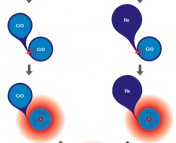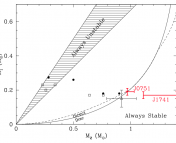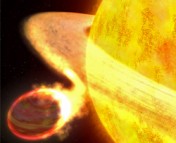Authors: Paula Izquierdo, Odette Toloza, Boris T. Gänsicke, Pablo Rodríguez-Gil, Jay Farihi, Detlev Koester, Jincheng Guo and Seth Redfield
First author’s institution: Instituto de Astrofísica de Canarias and Departamento de Astrofísica, Universidad de La Laguna, Tenerife, Spain
Status: Published in MNRAS (closed access)
White dwarfs are the remnants of a once vibrant main sequence star, like our Sun. But, what happens to the planets that were in that solar system after the star dies? In recent years, astronomers have observed unexpected metals (elements heavier than hydrogen and helium) in the spectra of white dwarfs, indicating the destruction and accretion of a planet into the former star’s photosphere.
Without these metals, white dwarf spectra usually show mostly hydrogen, helium, carbon, or oxygen, since the outer layers of the star were lost when they were blown off into a planetary nebula at the end of the star’s life, revealing the stellar core. There are many types of white dwarfs (based on which of these elements show up in their spectra), one of which is the helium-dominated white dwarf. If we observe a helium white dwarf with extra hydrogen in its spectrum, the natural question then is—where did that hydrogen come from? Astronomers consider three possibilities: hydrogen that’s simply left over from earlier in the star’s life, hydrogen accreted from an external source (like the interstellar medium or a planet), or hydrogen dredged-up from the deeper layers of the star.
Previous research surveyed a number of white dwarfs and found that hydrogen was almost twice as common in stars with metal pollution than those without, indicating that planets could be the reason for the excess hydrogen. A different study confirmed that planet accretion contributes to hydrogen in metal-polluted white dwarfs by looking at excesses of oxygen in their spectra. Oxygen is interpreted as coming from the accretion of water, so that means there would be some hydrogen accreted, too!
Today’s paper takes a detailed look at GD 424, a metal-polluted, helium white dwarf (with a large amount of hydrogen!). By studying the spectrum of this star in detail, the authors want to figure out the history of the accreting white dwarf and the composition of the destroyed planet.
First things first: know your star!
Using observations of spectra and photometry from the William Herschel Telescope at the Observatorio del Roque de los Muchachos on La Palma, Spain, the authors observed GD 424 and found that it had “a helium-dominated photosphere with presence of hydrogen and a number of much narrower metallic absorption lines of oxygen, magnesium, silicon, and calcium.” They first needed to use models to understand properties of the white dwarf’s photosphere, like temperature and surface gravity. Once these were determined, they were able to determine abundances for the different metals observed (see Figure 1 for GD 424’s spectrum, showing absorption lines for different elements).
So, what’s going on with that accretion then?
To come up with the composition of the accreted planet, we’d have to make some assumptions about when the accretion started and how fast the accretion is happening. The authors use a simple model for accretion, which happens in three stages: increasing accretion (which leads to a linear increase in metal abundance), steady state accretion (where the metals reach equilibrium in the photosphere), and decreasing accretion (where metals exponentially decay due to diffusion and sinking into the white dwarf). All of this comes down to one takeaway: metal abundance depends on the balance between accretion (how much is going into the photosphere) and diffusion/sinking (how much is going out of the photosphere).
Unfortunately, there are no obvious clues to which of these three states the star is in, so the authors tested all three. Both the increasing and steady states seem possible, and would imply a planet similar to the composition of Earth but with a bit too much calcium (see Figure 2 for comparisons of metallicity!). The accretion rate is among the highest observed for white dwarfs, and it’s already accreted at least the mass of the solar system asteroid 10 Hygeia!
Another interesting piece of the puzzle is figuring out how much water was on this Earth-like planet. The authors come up with the water content by looking at excess oxygen that can’t be accounted for with other common minerals, such as magnesium oxide (MgO) or titanium dioxide (TiO2). Turns out, GD 424 is currently accreting dry, rocky planetary debris.
Where did its excess hydrogen come from then?!
If the planet that’s currently being accreted didn’t have water, then where’s all the excess hydrogen from? Well, for hydrogen to show up in the spectrum it had to be accreted recently, after the white dwarf had sufficiently cooled to keep the hydrogen around in the photosphere. This means the hydrogen likely had to come from a previous accretion episode, where a different water-rich planet was destroyed, and the oxygen from that episode is gone simply because it diffuses out on a shorter timescale.
Now that we know all the pieces, we can put the whole story together: Since transitioning off the main sequence, GD 424 has eaten a whole water-rich planet, and now it’s accreting dry, rocky debris from another planet. Who knows if there’s anything left on the menu, but one thing is for certain: GD 424 is a very hungry white dwarf.
Astrobite edited by: Keir Birchall and Huei Sears
Featured image credit: Eric Carle and AAS Nova




